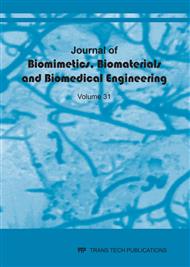[1]
Davis, J. W. 1910. Skin transplantation with a review of 550 cases at the Johns Hopkins Hospital. Johns Hopkins Med J 15: 307.
Google Scholar
[2]
Trelford JD, Trelford Suaer M. 1979. The amnion in surgery, past and present. Am J Obstet Gynecol; 134: 833-845.
DOI: 10.1016/0002-9378(79)90957-8
Google Scholar
[3]
Yin, Lan and Yu-Li Pi. 2011. Effect of amnion membrane transplantation on corneal neovascularization in 10 patients with alkali burn. China: Int J Opthalmol.
Google Scholar
[4]
Niknejad, Hassan, et al. 2008. Properties of Amniotic Membrane for Potential Use in Tissue Engineering. European Cells and Materials Vol. 15 pages 88-99.
Google Scholar
[5]
Peng, Chuangang, et al. 2012. Strain and stress variations in the human amniotic membrane and fresh corpse autologous sciatic nerve in a model of sciatic nerve injury. China: Neural Regeneration Research.
Google Scholar
[6]
Tseng SC, Li DQ & Ma X. 1999. Suppression of transforming growth factor-beta isoforms, TGF-beta receptor type II, and myofibroblast differentiation in cultured human corneal and limbal fibroblasts by amniotic membrane matrix. J Cell Physiol.
DOI: 10.1002/(sici)1097-4652(199906)179:3<325::aid-jcp10>3.0.co;2-x
Google Scholar
[7]
Lee SB, Li DQ, Tan DT, Meller DC, Tseng SC. 2000. Suppression of TGF-beta signaling in both normal conjunctival fibroblasts and pterygial body fibroblasts by amniotic membrane. Curr Eye Res 20: 325-334.
DOI: 10.1076/0271-3683(200004)2041-5ft325
Google Scholar
[8]
Solomon A., et al. 2001. Suppression of interleukin 1α and interleukin 1β in human limbal epithelial cells cultured on the amniotic membrane stromal matrix. Br J Ophthalmol; 85: 444-449.
DOI: 10.1136/bjo.85.4.444
Google Scholar
[9]
Hao Y., et al. 2000. Identification of antiangiogenic and anti-inflammatory proteins in human amniotic membrane. Cornea; 19: 348-352.
DOI: 10.1097/00003226-200005000-00018
Google Scholar
[10]
Kim, J. S., et. al. 2000. Amniotic membrane patching promotes healing and inhibits proteinase activity on wound healing following acute corneal alkali burn. Exp Eye Res; 70: 329-337.
DOI: 10.1006/exer.1999.0794
Google Scholar
[11]
Higa, K., et al. 2005. Hyaluronic acid-CD44 interaction mediates the adhesion of lymphocytes by amniotic membrane stroma. Cornea 24: 206-212.
DOI: 10.1097/01.ico.0000133999.45262.83
Google Scholar
[12]
Ni J., et al. 1997. Cystatin E is a novel human cysteine proteinase inhibitor with structural resemblance to family 2 cystatins. J Biol Chem; 272: 10853-10858.
DOI: 10.1074/jbc.272.16.10853
Google Scholar
[13]
Kjaergaard N., et al. 2001. Antibacterial properties of human amnion and chorion in vitro. Eur J Obstet Gynecol Reprod Biol; 94: 224-229.
Google Scholar
[14]
Widyatama, D. 2011. Efektifitas Kombinasi Glutaraldehid dan Didecil Dimetil Amonium Klorida sebagai Desinfektan Terhadap Penurunan Jumlah Bakteri pada Kandang Ayam Layer. Surabaya: Airlangga University.
Google Scholar
[15]
Vogel, H. 1987. Age dependence of mechanical and biochemical properties of human skin. Bioengineering and the skin 3, 67–91.
Google Scholar
[16]
Peng, Chuangang, et al. 2012. Strain and stress variations in the human amniotic membrane and fresh corpse autologous sciatic nerve in a model of sciatic nerve injury. China: Neural Regeneration Research.
Google Scholar
[17]
Shitaba H., Shioya N., Kuroyangi Y. 1997. Development of New Wound Dressing Composed of Spongy Collagen Sheet Containing Dibutyryl Cyclic AMP. J Biomater Sci Polym Ed 1997; 8: 601-21.
DOI: 10.1163/156856297x00209
Google Scholar
[18]
Draye, JP. Delaey B., Van den Voorde A., De Reu B., Schact E. 1998. In Vitro and In Vivo Biocompatibility of Dextran Dialdehyde Cross-Linked gelatin Hydrogel Film. Biomaterials 1998; 19: 1677-87.
DOI: 10.1016/s0142-9612(98)00049-0
Google Scholar
[19]
Spoerl E, Wollensak G, Reber F, Pillunat L, 2004. Cross-linking of human amniotic membrane by glutaraldehyde. Ophthalmic Res. 2004 Mar- Apr; 36(2): 71-7.
DOI: 10.1159/000076884
Google Scholar
[20]
Samaniego , A.S., et al. 2009. Human Amnion Tissue as an Anti-adhesion, Anti-inflammatory Barrier in an Ovine Laminectomy Model. Colorado State University, Ft. Collins. CO: USA.
Google Scholar
[21]
Pavia, et al. 2009. Introduction to Spectroscopy 4th edition. Washington: Brooks/Cole Cengage Learning.
Google Scholar
[22]
Jui-Yang lai, David hui-Kang Ma, 2013. Glutaraldehyde cross-linking of amniotic membranes affects their nanofirous structures and limbal epithelial cell culture characteristics. International Journal of Nanomedicine 2013 8 : 4157–4168.
DOI: 10.2147/ijn.s52731
Google Scholar
[23]
Weadock KS, Miller EJ, Keuffel EL, Dunn MG. 1996. Effect of physical crosslinking methods on collagen-fiber durability in proteolytic solutions. J Biomed Mater Res; 32: 221–226.
DOI: 10.1002/(sici)1097-4636(199610)32:2<221::aid-jbm11>3.0.co;2-m
Google Scholar
[24]
Spielmann, H., et al. 2007. The ECVAM International Validation Study on In VitroTests for Acute Skin Irritation: Report on the Validity of the EPISKIN and EpiDerm Assays and on the Skin Integrity Function Test. Germany: ATLA.
DOI: 10.1177/026119290703500614
Google Scholar
[25]
Mansjoer, Arif, dkk. 2000. Kapita Selekta Kedokteran Edisi III. Faculty of Medicine of University of Indonesia: Aescullapius.
Google Scholar
[26]
Baradaran-Raffi, A., et al. 2007. Amniotic Membrane Transplantation. IRANIAN JOURNAL OF OPHTHALMIC RESEARCH 2007; Vol. 2, No. 1.
Google Scholar


